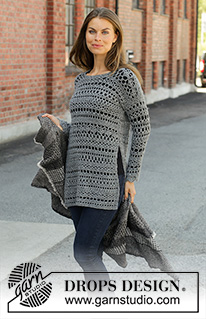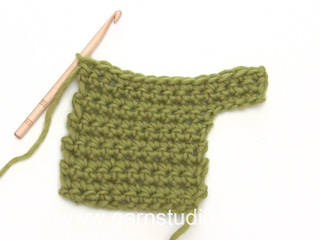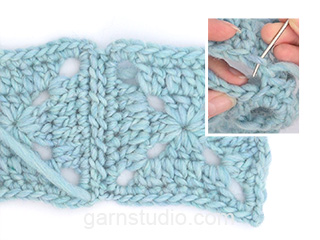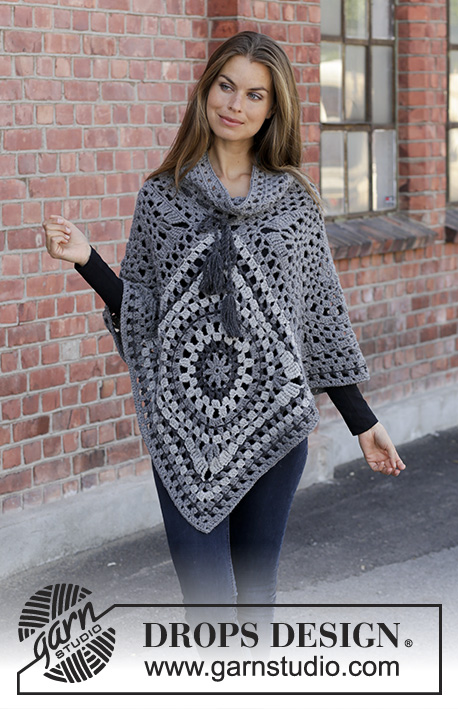Grey Sparrow |
|||||||||||||||||||||||||
 |
 |
||||||||||||||||||||||||
Crocheted jumper in DROPS Sky. The piece is worked top down with lace pattern and long split in the sides. Sizes S - XXXL.
DROPS 195-14 |
|||||||||||||||||||||||||
|
------------------------------------------------------- EXPLANATIONS FOR THE PATTERN: ------------------------------------------------------- CROCHET INFO: At the beginning of each row of treble crochets, the first treble crochet is replaced by 3 chain stitches. The row finishes with 1 treble crochet in the 3rd or 2nd chain stitch from the beginning of the previous row (depending on whether the previous row started with 3 or 2 chain stitches). At the beginning of each row of double crochets, the first double crochet is replaced by 2 chain stitches. The row finishes with 1 double crochet in the 3rd or 2nd chain stitch from the beginning of the previous round. PATTERN: See diagrams A.1 to A.3. DECREASE TIP (for sleeves): Decrease 1 stitch inside of the 2 outermost stitches in each side. Decrease 1 stitch by skipping 1 stitch. It is difficult to say where the decreases will occur in the pattern, but adjust so that you decrease on a row of treble/double crochets (not on a row of large chain-spaces). INCREASE TIP (for bottom of sleeves): Increase 1 stitch by working 2 double crochets in same stitch. ------------------------------------------------------- START THE PIECE HERE: ------------------------------------------------------- JUMPER - QUICK SUMMARY OF THE PIECE: Front and back pieces are worked back and forth separately, top down. You first work the right front shoulder increasing for the neck, then the left shoulder increasing for the neck before the pieces are worked together back and forth to finished length. The back piece is worked in the same way. The sleeves are worked back and forth, top down. The garment is sewn together before working a finishing edge to the neck. RIGHT FRONT SHOULDER (when the garment is worn): Read CROCHET INFO! Work 28-28-36-44-44-52 chain stitches with hook size 4.5 mm and Sky. The first row is worked as follows from the wrong side: Work 1 treble crochet in the 4th chain stitch from the hook, * skip 1 chain stitch, work 1 treble crochet in each of the next 3 chain stitches *, work from *-* to end of row = 20-20-26-32-32-38 treble crochets on the row. The next row is worked as follows from the right side: Work A.1A (= 2 stitches), work A.1B over the next 12-12-18-24-24-30 stitches (= 2-2-3-4-4-5 repeats of 6 stitches) and finish with A.1C (= 6 stitches). Continue this pattern back and forth until A.1 has been completed. REMEMBER THE CROCHET TENSION! Lay the piece to one side and work the left front shoulder as described below. LEFT FRONT SHOULDER (when the garment is worn): Work 28-28-36-44-44-52 chain stitches with hook size 4.5 mm and Sky. The first row is worked as follows from the wrong side: Work 1 treble crochet in the 4th chain stitch from the hook, * skip 1 chain stitch, work 1 treble crochet in each of the next 3 chain stitches *, work from *-* to end of row = 20-20-26-32-32-38 treble crochets on the row. The next row is worked as follows from the right side: Work A.1D (= 7 stitches), work A.1B over the next 6-6-12-18-18-24 stitches (= 1-1-2-3-3-4 repeats of 6 stitches) and finish with A.1E (= 7 stitches). Continue this pattern back and forth until A.1 has been completed. At the end of the last row, work 25-31-25-25-31-31 slightly loose chain stitches for the neck. Fasten the loose chains with 1 slip stitch in the outermost stitch towards the neck on right shoulder on the front (from wrong side). Cut and fasten the strand. Now work the pieces together for the front piece as described below. FRONT PIECE: Start from the right side of the right front shoulder; continue working over the chain stitches for the neck and then work over the stitches on the left front shoulder as follows: Work A.2A (= 2 stitches), work A.2B over the next 60-66-72-84-90-102 stitches (= 10-11-12-14-15-17 repeats of 6 stitches) and finish with A.2C (= 7 stitches). NOTE: When working over the chain stitches for the neckline, work 1 treble crochet in each chain stitch. Continue this pattern back and forth. When A.2 has been worked one time in height, work A.3 one time in height in the same way. Then work A.2 to finished length, NOTE: When A.2 is repeated after itself, the 1st row on the 2nd repeat will be worked from wrong side. The 1st treble crochet on row is replaced with 3 chain stitches as usual. AT THE SAME TIME when the piece measures 18-18-20-20-22-23 cm from the cast-on edge, insert 1 marker in each side to mark the armholes. Continue working as described above until the piece measures approx. 65-67-69-71-73-75 cm. Finish with 1 row of treble crochets – NOTE: Choose a row from one of the diagrams which fits with where you are in the repeat so that you have 69-75-81-93-99-111 treble crochets on the row. Cut and fasten the strands. The front piece measures approx. 66-68-70-72-74-76 cm from the shoulder down. LEFT BACK SHOULDER (when the garment is worn): Work 28-28-36-44-44-52 chain stitches with hook size 4.5 mm and Sky. The first row is worked as follows from the wrong side: Work 1 treble crochet in the 4th chain stitch from the hook, * skip 1 chain stitch, work 1 treble crochet in each of the next 3 chain stitches *, work from *-* to end of row = 20-20-26-32-32-38 treble crochets on the row. Lay the piece to one side and work the right back shoulder as described below. RIGHT BACK SHOULDER (when the garment is worn) Work 28-28-36-44-44-52 chain stitches with hook size 4.5 mm and Sky. The first row is worked as follows from the wrong side: Work 1 treble crochet in the 4th chain stitch from the hook, * skip 1 chain stitch, work 1 treble crochet in each of the next 3 chain stitches *, work from *-* to end of row = 20-20-26-32-32-38 treble crochets on row. At the end of this row, work 29-35-29-29-35-35 slightly loose chain stitches for the neck. Fasten the loose chains with 1 slip stitch in the outermost stitch towards the neck on left shoulder on the back (from wrong side). Cut and fasten the strand.Now work the pieces together for the back piece as described below. BACK PIECE: Start from the right side of the left back shoulder; continue working over the chain stitches for the neck and then over the stitches on the right back shoulder as follows: Work A.1A (= 2 stitches), work A.1B over the next 60-66-72-84-90-102 stitches (= 10-11-12-14-15-17 repeats of 6 stitches) and finish with A.1E (= 7 stitches). Continue this pattern back and forth. When A.1 has been completed, work A.2 in the same way. When A.2 has been worked one time in height, work A.3 one time in height in the same way. Then work A.2 to finished length in the same way as the front piece. AT THE SAME TIME when the piece measures 18-18-20-20-22-23 cm from the cast-on edge, insert 1 marker in each side to mark the armholes. Continue working as described above until the piece measures approx. 65-67-69-71-73-75 cm – adjust to match the front piece. Finish with 1 row of treble crochets in the same way as the front piece. Cut and fasten the strands. The back piece measures approx. 66-68-70-72-74-76 cm from the shoulder down. SLEEVE: Work 77-77-85-85-93-101 chain stitches with hook size 4.5 mm and Sky. The first row is worked as follows from the right side: Work 1 treble crochet in the 4th chain stitch from the hook, work 1 treble crochet in the next chain stitch, * skip 1 chain stitch, work 1 treble crochet in each of the next 3 chain stitches *, work from *-* to end of row = 57-57-63-63-69-75 treble crochets on the row. The next row is worked as follows from the wrong side: 4 chain stitches (equivalent to 1 treble crochet + 1 chain stitch), skip 2 treble crochets, * 2 treble crochets in the space before the next 3 treble crochets, 1 chain stitch * work from *-* until there are 3 treble crochets left on the row, skip 2 treble crochets and finish with 1 treble crochet in the last treble crochet = 57-57-63-63-69-75 stitches on the row. The next row is worked as follows from the right side: Work A.2A (= 2 stitches), work A.2B over the next 48-48-54-54-60-66 stitches (= 8-8-9-9-10-11 repeats of 6 stitches) and finish with A.2C (= 7 stitches). Continue this pattern back and forth. A.2 is repeated in height. AT THE SAME TIME when the piece measures 2 cm in all sizes, decrease 1 stitch in each side – read DECREASE TIP (= 2 stitches decreased). Decrease like this approx. every 5½-5½-4½-4-3½-2½ cm a total of 9-9-11-11-13-15 times in each side = 39-39-41-41-43-45 stitches on the row. When the sleeve measures approx. 50-49-48-46-45-42 cm (shorter measurements in larger sizes due to wider shoulders) work 1 row of double crochets from the wrong side where you increase 6-6-4-4-8-6 stitches evenly on the row - read INCREASE TIP = 45-45-45-45-51-51 double crochets. The next row is worked as follows from the right side: Work A.1A (= 2 stitches), work A.1B over the next 36-36-36-36-42-42 stitches (= 6-6-6-6-7-7 repeats of 6 stitches) and finish with A.1E (= 7 stitches). Continue this pattern, but finish after the 3rd row of A.1. Cut and fasten the strands. The sleeve measures approx. 54-53-52-50-49-46 cm from the top down. Work the other sleeve in the same way. ASSEMBLY: Sew the shoulder seams. Sew in the sleeves between the markers on the front and back pieces. Sew the sleeve and side seams in one go – start at the bottom of the sleeve and sew edge to edge in the outermost stitch, but finish the seam when there is still 34 cm left, leaving a split in each side. NECK: Start on the one shoulder and work the first round as follows with hook size 4.5 mm: Work 1 double crochet in the first stitch, * 3 chain stitches, 1 double crochet around the next row/chain-space *, work from *-* around the whole neck, finish with 3 chain stitches and 1 slip stitch in the first double crochet at the beginning of the round. Work slip stitches to the middle of the first chain-space, work 3 chain stitches, * 1 double crochet around the next chain-space, 2 chain stitches *, work from *-* to end of round, finish with 1 slip stitch in the first chain stitch at the beginning of the round. Cut and fasten the strand. |
|||||||||||||||||||||||||
Diagram explanations |
|||||||||||||||||||||||||
|
|||||||||||||||||||||||||

|
|||||||||||||||||||||||||

|
|||||||||||||||||||||||||

|
|||||||||||||||||||||||||

|
|||||||||||||||||||||||||
|
Have you made this or any other of our designs? Tag your pictures in social media with #dropsdesign so we can see them! Do you need help with this pattern?You'll find tutorial videos, a Comments/Questions area and more by visiting the pattern on garnstudio.com. © 1982-2024 DROPS Design A/S. We reserve all rights. This document, including all its sub-sections, has copyrights. Read more about what you can do with our patterns at the bottom of each pattern on our site. |
|||||||||||||||||||||||||























































Comments / Questions (61)
Det fattas förklaring till virksymboler på mönster 195-14\r\nVissa symboler finns inte heller med i er information vad gäller ”lära sig virka efter mönster”\r\nTacksam för svar\r\nMvh Britt-Louise
24.11.2023 - 20:45Buongiorno, il campione dato lo devo svolgere con che punti? A maglia alta? Perché non è specificato Grazie mille
23.10.2023 - 06:59DROPS Design answered:
Buonasera Velvet79_it, all'inizio del lavoro è specificato che il campione è lavorato a maglie alte. Buon lavoro!
23.10.2023 - 22:27I am struggling with joining the back shoulders and starting the back piece pattern. I can’t understand how to incorporate the chain without creating a step, or uneven pattern. Thank you
26.09.2023 - 20:41DROPS Design answered:
Dear Suzanne, you first work 1 row treble crochets (UK-English terminology) over first shoulder, then over 2nd shoulder and at the end of this row on 2nd shoulder, crochet chain stitches for neck and join with a slip stitch to the first shoulder, cut the yarn and now work BACK PIECE. Happy knitting!
29.09.2023 - 07:56Hola otra vez....gracias por las instrucciones en Español, aunque ya las tenia! Y sigo teniendo el mismo problema, en la segunda vuelta, si hago los dos puntos altos antes de cada grupo de tres, me salen muchos menos puntos que los que pone en el patron! .....que es lo que hago mal?
28.09.2022 - 22:53DROPS Design answered:
Hola Montserrat, parece ser una errata en la traducción en español. Serían 57-57-63-63-69-75 puntos en la fila (sumando los puntos altos y los puntos de cadeneta). Lo corregiremos lo antes posible.
09.10.2022 - 23:09Era referido a las mangas, justo al principio....gracias!
25.09.2022 - 20:51DROPS Design answered:
Hola Montse, puedes ver la respuesta debajo.
25.09.2022 - 22:12Ui..no se envió mi primera parte... en esta vuelta tengo problemas: The next row is worked as follows from the wrong side: 4 chain stitches (equivalent to 1 treble crochet + 1 chain stitch), skip 2 treble crochets, * 2 treble crochets in the space before the next 3 treble crochets, 1 chain stitch * work from *-* until there are 3 treble crochets left on the row, skip 2 treble crochets and finish with 1 treble crochet in the last treble crochet = 57-57-63-63-69-75 stitches on the row.
25.09.2022 - 20:50DROPS Design answered:
Hola Montse, puedes ver aquí las instrucciones en español por si te resuelven dudas: La siguiente fila se trabaja como sigue por el lado revés: 4 puntos de cadeneta (equivalente a 1 punto alto + 1 punto de cadeneta), saltar 2 puntos altos, * 2 puntos altos en el arco antes de los siguientes 3 puntos altos, 1 punto de cadeneta*, trabajar de * a * hasta que solo queden 3 puntos altos en la fila, saltar 2 puntos altos y finalizar con 1 punto alto en el último punto alto = 57-57-63-63-69-75 puntos altos en la fila. Puedes encontrar el patrón en español en este link: https://www.garnstudio.com/pattern.php?id=8692&cid=23
25.09.2022 - 21:05Sigo.... Entiendo que tengo que hacer dos puntos altos cada tres puntos altos de la vuelta anterior, pero entonces me salen muchos menos puntos de los que dice el patrón, unos 40 o menos....o son dos puntos altos cada dos puntos altos de la vuelta anterior, con lo que me falta un punto alto para tener los 63 que dices que tengo que tener al final de la vuelta..... Espero que me saques de este lio! Gracias!!
25.09.2022 - 20:47DROPS Design answered:
Hola Montse, puedes ver la respuesta arriba.
25.09.2022 - 22:12I love your designs. However, I find it difficult to use diagrams only. I so much prefer written instructions , stitch by stitch. Maybe that is something you can consider for the future.
14.12.2021 - 02:14Vielen Dank für Ihre Antwort! Sie haben natürlich recht, das war ein kompletter Denkfehler von mir. Habe schon lange nicht mehr nach einer Häkelschrift gearbeitet.
23.11.2021 - 05:26Entschuldigung, ich meinte A2A, B und C.
17.11.2021 - 21:24